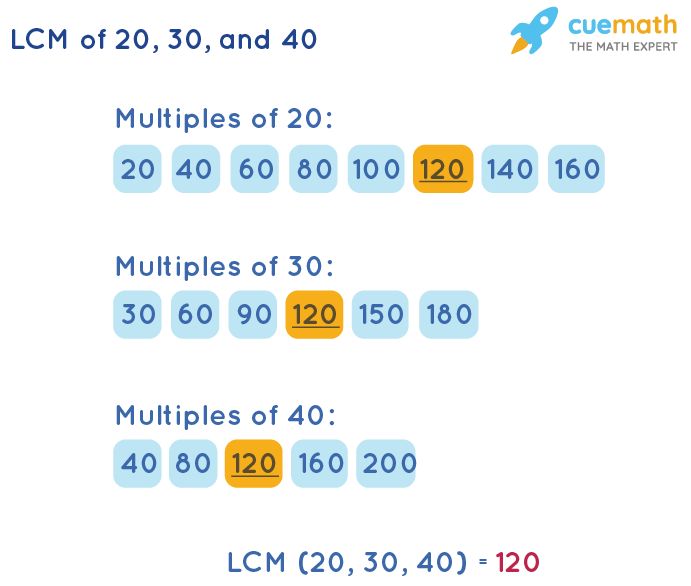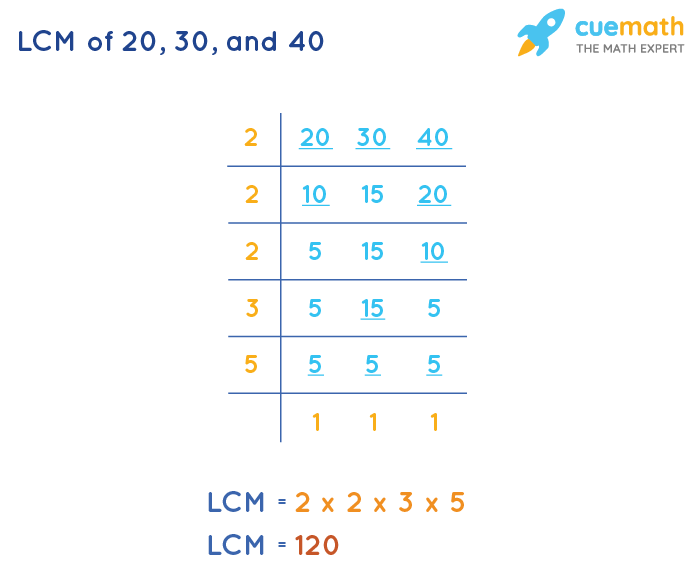LCM of 20, 30, and 40
LCM of 20, 30, and 40 is the smallest number among all common multiples of 20, 30, and 40. The first few multiples of 20, 30, and 40 are (20, 40, 60, 80, 100 . . .), (30, 60, 90, 120, 150 . . .), and (40, 80, 120, 160, 200 . . .) respectively. There are 3 commonly used methods to find LCM of 20, 30, 40 - by prime factorization, by division method, and by listing multiples.
| 1. | LCM of 20, 30, and 40 |
| 2. | List of Methods |
| 3. | Solved Examples |
| 4. | FAQs |
What is the LCM of 20, 30, and 40?
Answer: LCM of 20, 30, and 40 is 120.

Explanation:
The LCM of three non-zero integers, a(20), b(30), and c(40), is the smallest positive integer m(120) that is divisible by a(20), b(30), and c(40) without any remainder.
Methods to Find LCM of 20, 30, and 40
The methods to find the LCM of 20, 30, and 40 are explained below.
- By Listing Multiples
- By Division Method
- By Prime Factorization Method
LCM of 20, 30, and 40 by Listing Multiples

To calculate the LCM of 20, 30, 40 by listing out the common multiples, we can follow the given below steps:
- Step 1: List a few multiples of 20 (20, 40, 60, 80, 100 . . .), 30 (30, 60, 90, 120, 150 . . .), and 40 (40, 80, 120, 160, 200 . . .).
- Step 2: The common multiples from the multiples of 20, 30, and 40 are 120, 240, . . .
- Step 3: The smallest common multiple of 20, 30, and 40 is 120.
∴ The least common multiple of 20, 30, and 40 = 120.
LCM of 20, 30, and 40 by Division Method

To calculate the LCM of 20, 30, and 40 by the division method, we will divide the numbers(20, 30, 40) by their prime factors (preferably common). The product of these divisors gives the LCM of 20, 30, and 40.
- Step 1: Find the smallest prime number that is a factor of at least one of the numbers, 20, 30, and 40. Write this prime number(2) on the left of the given numbers(20, 30, and 40), separated as per the ladder arrangement.
- Step 2: If any of the given numbers (20, 30, 40) is a multiple of 2, divide it by 2 and write the quotient below it. Bring down any number that is not divisible by the prime number.
- Step 3: Continue the steps until only 1s are left in the last row.
The LCM of 20, 30, and 40 is the product of all prime numbers on the left, i.e. LCM(20, 30, 40) by division method = 2 × 2 × 2 × 3 × 5 = 120.
LCM of 20, 30, and 40 by Prime Factorization
Prime factorization of 20, 30, and 40 is (2 × 2 × 5) = 22 × 51, (2 × 3 × 5) = 21 × 31 × 51, and (2 × 2 × 2 × 5) = 23 × 51 respectively. LCM of 20, 30, and 40 can be obtained by multiplying prime factors raised to their respective highest power, i.e. 23 × 31 × 51 = 120.
Hence, the LCM of 20, 30, and 40 by prime factorization is 120.
☛ Also Check:
- LCM of 8, 12 and 24 - 24
- LCM of 18, 36 and 27 - 108
- LCM of 22 and 33 - 66
- LCM of 6, 8 and 15 - 120
- LCM of 25 and 75 - 75
- LCM of 45 and 99 - 495
- LCM of 5 and 13 - 65
LCM of 20, 30, and 40 Examples
-
Example 1: Calculate the LCM of 20, 30, and 40 using the GCD of the given numbers.
Solution:
Prime factorization of 20, 30, 40:
- 20 = 22 × 51
- 30 = 21 × 31 × 51
- 40 = 23 × 51
Therefore, GCD(20, 30) = 10, GCD(30, 40) = 10, GCD(20, 40) = 20, GCD(20, 30, 40) = 10
We know,
LCM(20, 30, 40) = [(20 × 30 × 40) × GCD(20, 30, 40)]/[GCD(20, 30) × GCD(30, 40) × GCD(20, 40)]
LCM(20, 30, 40) = (24000 × 10)/(10 × 10 × 20) = 120
⇒LCM(20, 30, 40) = 120 -
Example 2: Find the smallest number that is divisible by 20, 30, 40 exactly.
Solution:
The smallest number that is divisible by 20, 30, and 40 exactly is their LCM.
⇒ Multiples of 20, 30, and 40:- Multiples of 20 = 20, 40, 60, 80, 100, 120, . . . .
- Multiples of 30 = 30, 60, 90, 120, 150, . . . .
- Multiples of 40 = 40, 80, 120, 160, 200, . . . .
Therefore, the LCM of 20, 30, and 40 is 120.
-
Example 3: Verify the relationship between the GCD and LCM of 20, 30, and 40.
Solution:
The relation between GCD and LCM of 20, 30, and 40 is given as,
LCM(20, 30, 40) = [(20 × 30 × 40) × GCD(20, 30, 40)]/[GCD(20, 30) × GCD(30, 40) × GCD(20, 40)]
⇒ Prime factorization of 20, 30 and 40:- 20 = 22 × 51
- 30 = 21 × 31 × 51
- 40 = 23 × 51
∴ GCD of (20, 30), (30, 40), (20, 40) and (20, 30, 40) = 10, 10, 20 and 10 respectively.
Now, LHS = LCM(20, 30, 40) = 120.
And, RHS = [(20 × 30 × 40) × GCD(20, 30, 40)]/[GCD(20, 30) × GCD(30, 40) × GCD(20, 40)] = [(24000) × 10]/[10 × 10 × 20] = 120
LHS = RHS = 120.
Hence verified.

FAQs on LCM of 20, 30, and 40
What is the LCM of 20, 30, and 40?
The LCM of 20, 30, and 40 is 120. To find the least common multiple (LCM) of 20, 30, and 40, we need to find the multiples of 20, 30, and 40 (multiples of 20 = 20, 40, 60, 80, 120 . . . .; multiples of 30 = 30, 60, 90, 120 . . . .; multiples of 40 = 40, 80, 120, 160 . . . .) and choose the smallest multiple that is exactly divisible by 20, 30, and 40, i.e., 120.
Which of the following is the LCM of 20, 30, and 40? 30, 24, 20, 120
The value of LCM of 20, 30, 40 is the smallest common multiple of 20, 30, and 40. The number satisfying the given condition is 120.
What are the Methods to Find LCM of 20, 30, 40?
The commonly used methods to find the LCM of 20, 30, 40 are:
- Division Method
- Prime Factorization Method
- Listing Multiples
What is the Relation Between GCF and LCM of 20, 30, 40?
The following equation can be used to express the relation between GCF and LCM of 20, 30, 40, i.e. LCM(20, 30, 40) = [(20 × 30 × 40) × GCF(20, 30, 40)]/[GCF(20, 30) × GCF(30, 40) × GCF(20, 40)].
visual curriculum